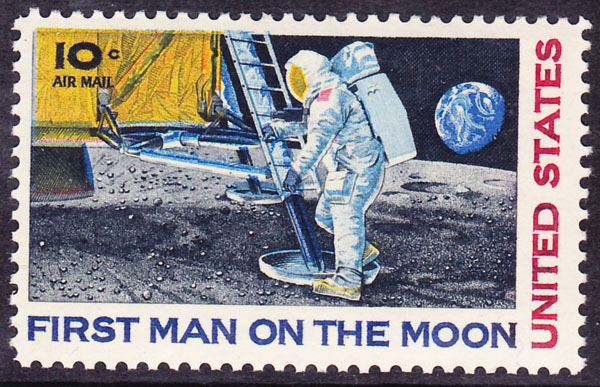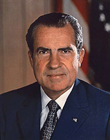Purposeful Arrangement of Sentences
In the first section of this lesson, you were reminded that revising is rewriting, adding, deleting, and rearranging sentences and paragraphs. In this section, we will focus on individual sentences within your paragraphs. You will learn strategies for polishing the syntax of your essay by creating schemes. You may want to try using schemes of balance, interruption, omission, and repetition during the revision process.
Balance can be achieved by using parallel structure and/or the antithesis of words, phrases, or clauses. Click the links below to see and hear antithesis used for a variety of purposes. Then use the chart that follows to identify the antithetical terms. Lloyd Braun’s antithesis has been filled in on the chart for you as an example. As you read and listen, consider each speaker’s purpose and occasion.
Antithesis (an-TIH-theh-sis): Figure of balance in which two contrasting ideas are intentionally juxtaposed, usually through parallel structure; a contrasting of opposing ideas in adjacent phrases, clauses, or sentences, as shown in these two examples:
“He is no fool who gives what he cannot keep to gain that which he cannot lose.” —Jim Elliot
“Serenity now; insanity later.” —Lloyd Braun in Seinfeld episode “The Serenity Now”
“I have a dream that my four little children will one day live in a nation where they will not be judged by the color of their skin but by the content of their character. I have a dream today!”
“The world will little note, nor long remember, what we say here, but it can never forget what they did here.”
“ . . . although the surface appears to be...very, very fine-grained as you get close to it. It’s almost like a powder . . . Okay, I’m going to step off the LEM now. That’s one small step for [a] man; one giant leap for mankind.”
“Those of us who loved him and who take him to his rest today pray that what he was to us and what he wished for others will someday come to pass for all the world. As he said many times, in many parts of this nation, to those he touched and who sought to touch him: ‘Some men see things as they are and say why. I dream things that never were and say why not.’”
“We observe today not a victory of party but a celebration of freedom, symbolizing an end as well as a beginning, signifying renewal as well as change.”
“I want to urge you, as many of you as can, to visit our country, and invite members of our Congress to visit you. Let them understand how the world looks from your perspective. Let them see how you do your jobs. Tell them what you're worried about and where you disagree with us. And give us a chance to build that base of common experience and mutual trust that is so important to our future together . . . We must have a sense of responsibility for the future. We are not destined to be adversaries. But it is not guaranteed that we will be allies.”
“We find ourselves rich in goods but ragged in spirit, reaching with magnificent precision for the moon but falling into raucous discord on earth. We are caught in war, wanting peace. We're torn by division, wanting unity.”

Source: “Man on the Moon” Stamp, U.S. Post Office, Wikimedia Commons
For the activity that follows, drag and drop the antithetical phrases (A-F) to match the phrases in the middle column.






Source: Bill Clinton, Bob McNeely, Wikimedia Commons; MLK Leaning on a lectern, Library of Congress, Wikimedia Commons;
Edward “Ted” Kennedy, The White House, Wikimedia Commons; Richard Nixon, The White House, Wikimedia Commons;
Neil Armstrong, NASA.Gov, Wikimedia Commons; Abraham Lincoln, Alexander Gardner, Wikimedia Commons
A second scheme for varying your sentences in a purposeful way is interruption. You might use an appositive phrase to add detail when you revise. Click below to read “Appositio” at the American Rhetoric website. While you to listen to the audio for each example of “appositio,” pay careful attention to the punctuation in the written version. Appositives are usually set off with commas.
Appositio (apposition): Figure of addition in which words are placed side by side (in apposition to) each other with one word describing or clarifying the other; adjacent nouns or noun substitutes with one elaborating the other.
“I, Barbara Jordan, am a keynote speaker.”
“I am elated by the knowledge that for the first time in our history a woman, Geraldine Ferraro, will be recommended to share our ticket.”
“And I will carry this: it is the police shield of a man named George Howard, who died at the World Trade Center trying to save others. It was given to me by his mom, Arlene, as a proud memorial to her son.”
“Here, in the great, liberal state of Massachusetts, the cradle of liberty and abolitionism, a woman was arrested on a minor criminal charge.”
“And so I ask you tonight, the people of Massachusetts, to think this through with me. In facing this decision, I seek your advice and opinion. In making it, I seek your prayers.”
“John Fitzgerald Kennedy, a great and good President, a friend of all people of goodwill, a believer in the dignity and equality of all human beings, a fighter for justice, an apostle of peace, has been snatched from our midst by the bullet of an assassin.”
Another way to interrupt your reader, on purpose, is to use parentheses to provide factual or illustrative information. Read the following paragraphs from Truman Capote’s In Cold Blood, the chilling (and true) story of the brutal murders of a Kansas family in 1959. Capote’s purpose in this passage is to introduce the reader to a setting in which such a crime seems unfathomable. You will notice that Capote adds details parenthetically about Mr. C.J. (Buffalo) Jones, the menagerie in the park, and the free swimming pool. Adding details inside parentheses is a good strategy for revising your essays.
Read the passage below and consider the purpose Capote might have had in mind when he wrote it. When you are finished reading, consider the parenthetical expressions that follow and choose the purposes Capote might have had in mind when he wrote them.
The distance between Olathe, a suburb of Kansas, and Holcomb, which might be called a suburb of Garden City, is approximately four hundred miles.
A town of eleven thousand, Garden City began assembling its founders soon after the Civil War. An itinerant buffalo hunter, Mr. C.J. (Buffalo) Jones, had much to do with its subsequent expansion from a collection of huts and hitching posts into an opulent ranching center with razzle-dazzle saloons, an opera house, and the plushiest hotel anywhere between Kansas City and Denver—in brief, a specimen of frontier fanciness that rivaled a more famous settlement fifty miles east of it, Dodge City. Along with Buffalo Jones, who lost his money and then his mind (the last years of his life were spent haranguing street groups against the wanton extermination of the beasts he himself had so profitably slaughtered), the glamours of the past are today entombed. Some souvenirs exist; a moderately colorful row of commercial buildings is known as the Buffalo Block, and the once splendid Windsor Hotel, with its still splendid high-ceilinged saloon and its atmosphere of spittoons and potted palms, endures amid the variety stores and supermarkets as a Main Street landmark—one comparatively unpatronized, for the Windsor’s dark, huge chambers and echoing hallways, evocative as they are, cannot compete with the air-conditioned amenities offered at the trim little Hotel Warren, or with the Wheat Lands Motel’s individual television sets and “Heated Swimming Pool.”
Anyone who has made the coast-to-coast journey across America, whether by train or by car, has probably passed through Garden City, but it is reasonable to assume that few travelers remember the event. It seems just another fair-sized town in the middle—almost the exact middle—of the continental United States. Not that the inhabitants would tolerate such an opinion—perhaps rightly. Though they may overstate the case (“Look all over the world, and you won’t find friendlier people or fresher air or sweeter drinking water,” and “I could go to Denver at triple the salary, but I’ve got five kids, and I figure there’s no better place to raise kids than right here. Swell schools with every kind of sport. We even have a junior college,” and “I came out here to practice law. A temporary thing, I never planned to stay. But when the chance came to move, I thought, Why go? . . . Maybe it’s not New York—but who wants New York? Good neighbors, people who care about each other, that’s what And everything else a decent man needs—we’ve got that, too. Beautiful churches. A golf course”), the newcomer to Garden City, once he has adjusted to the nightly after-eight silence of Main Street, discovers much to support the defensive boastings of the citizenry: a well-run public library, a competent daily newspaper, green-lawned and shady squares here and there, placid residential streets where animals and children are safe to run free, a big, rambling park complete with a small menagerie (“See the Polar Bears!” “See Penny the Elephant!”), and a swimming pool that consumes several acres (“World’s Largest FREE Swim-pool!”). Such accessories, and the dust and the winds and the ever-calling train whistles, add up to a “home town” that is probably remembered with nostalgia by those who have left it, and that, for those who have remained, provides a sense of roots and contentment.

Source: Clutter Home in Holcome KS, Spacini at en.wikipedia, Wikimedia Commons
Now try your hand at polysyndeton, which is the opposite of asyndeton. Instead of omitting conjunctions, you will be adding them to this passage from the film Forrest Gump. Using your notes, write your responses. When you are finished, check your understanding below. The versatility of shrimp as a food will be emphasized. When you have finished, click below to see.
Anyway, like I was saying, shrimp is the fruit of the sea. You can barbecue it, boil it, broil it, bake it, saute it. Dey’s uh, shrimp-kabobs, shrimp creole, shrimp gumbo. Pan fried, deep fried, stir-fried. There’s pineapple shrimp, lemon shrimp, coconut shrimp, pepper shrimp, shrimp soup, shrimp stew, shrimp salad, shrimp and potatoes, shrimp burger, shrimp sandwich. That—that’s about it.
Sample Response:
Here is one possible revision from asyndeton to polysyndeton:
Anyway, like I was saying, shrimp is the fruit of the sea. You can barbecue it and boil it and broil it and bake it and saute it. Dey’s uh, shrimp-kabobs and shrimp creole and shrimp gumbo. Pan fried and deep fried and stir-fried. There’s pineapple shrimp and lemon shrimp and coconut shrimp and pepper shrimp and shrimp soup and shrimp stew and shrimp salad and shrimp and potatoes and shrimp burger and shrimp sandwich. That—that’s about it.
The final scheme for you to think about when you revise is repetition. Nordquist, whose webpage you visited earlier, says, “When it came to practicing effective strategies of repetition, rhetoricians in ancient Greece and Rome had a bag full of tricks, each with a fancy name.”
He challenges you to see if you can match the names of ten figures of speech with their appropriate definitions and examples. Answers appear at the end of the post, but the “fancy names” are not as important for you to learn as the many ways in which you can repeat yourself effectively within a sentence or group of sentences.
Open the Nordquist’s webpage titled “Would You Repeat That, Please?”. Use your notes to write your responses.